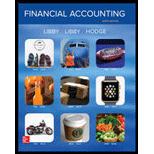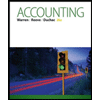
Concept explainers
Recording Transactions Affecting Stockholders’ Equity
King Corporation began operations in January of the current year. The charter authorized the following stock:
Common stock: $5 par value, 85,000 shares authorized
During the current year, the following transactions occurred in the order given:
- a. Issued 66,000 shares of common stock for $9 cash per share.
- b. Sold 9,000 shares of the preferred stock at $20 cash per share.
- c. Sold 1,000 shares of the preferred stock at $20 cash per share and 2,500 shares of common stock at $10 cash per share.
Required:
Provide the
Prepare the journal entries for given transaction.
Explanation of Solution
Common stock:
These are the ordinary shares that a corporation issues to the investors in order to raise funds. In return, the investors receive a share of profit from the profits earned by the corporation in the form of dividend.
Par value:
It refers to the value of a stock that is stated by the corporation’s charter. It is also known as face value of a stock.
Journal:
Journal is the method of recording monetary business transactions in chronological order. It records the debit and credit aspects of each transaction to abide by the double-entry system.
Rules of Debit and Credit:
Following rules are followed for debiting and crediting different accounts while they occur in business transactions:
- Debit, all increase in assets, expenses and dividends, all decrease in liabilities, revenues and stockholders’ equities.
- Credit, all increase in liabilities, revenues, and stockholders’ equities, all decrease in assets, expenses.
Journal entries for given transaction are as follows:
a. Issued 66,000 common shares at $9 per share:
| Date | Accounts title and explanation | Ref. | Debit ($) | Credit ($) |
| Cash (+A) (2) | 594,000 | |||
| Common stock (+SE) (1) | 330,000 | |||
| Additional paid-in capital, common stock (+SE) (3) | 264,000 | |||
| (To record the issuance of common stock) |
Table (1)
- Cash is an assets account and it increased the value of asset by $594,000. Hence, debit the cash account for $594,000.
- Common stock is a component of stockholder’s equity and it increased the value of stockholder’s equity by $330,000. Hence, credit the common stock for $330,000.
- Additional paid-in capital is a component of stockholder’s equity and it increased the value of stockholder’s equity by $264,000. Hence, credit the additional paid-in capital for $264,000.
Working note:
Calculate the value of common stock
Calculate the total cash received
Calculate the value of additional paid in capital
b. Issued 9,000 shares of preferred stock at $20 each:
| Date | Accounts title and explanation | Ref. | Debit ($) | Credit ($) |
| Cash (+A) (5) | 180,000 | |||
| Preferred stock (+SE) (4) | 90,000 | |||
| Additional paid-in capital, preferred stock (+SE) (6) | 90,000 | |||
| (To record the issuance of preferred stock) |
Table (2)
- Cash is an assets account and it increased the value of asset by $180,000. Hence, debit the cash account for $180,000.
- Preferred stock is a component of stockholder’s equity and it increased the value of stockholder’s equity by $90,000. Hence, credit the preferred stock for $90,000.
- Additional paid-in capital, preferred stock is a component of stockholder’s equity and it increased the value of stockholder’s equity by $90,000. Hence, credit the additional paid-in capital, preferred stock account for $90,000.
Working note:
Calculate the value of preferred stock
Calculate the total cash received
Calculate the value of additional paid in capital, preferred stock
c. Issued 2,500 common shares at $10 per share and issued 1,000 shares of preferred stock at $20 each:
| Date | Accounts title and explanation | Ref. | Debit ($) | Credit ($) |
| Cash (+A) (13) | 45,000 | |||
| Preferred stock (+SE) (7) | 10,000 | |||
| Common stock (+SE) (10) | 12,500 | |||
| Additional paid-in capital, preferred stock (+SE) (9) | 10,000 | |||
| Additional paid up capital, common stock(+SE) (12) | 12,500 | |||
| (To record issuance of common stock and preferred stock) |
Table (3)
- Cash is an assets account and it increased the value of asset by $45,000. Hence, debit the cash account for $45,000.
- Preferred stock is a component of stockholder’s equity and it increased the value of stockholder’s equity by $10,000. Hence, credit the preferred stock for $10,000.
- Common stock is a component of stockholder’s equity and it increased the value of stockholder’s equity by $12,500, Hence, credit the common stock for $12,500.
- Additional paid-in capital, preferred stock is a component of stockholder’s equity and it increased the value of stockholder’s equity by $10,000. Hence, credit the additional paid-in capital, preferred stock account for $10,000.
- Additional paid up capital, common stock is a component of stockholder’s equity and it increased the value of stockholder’s equity by $12,500. Hence, credit the additional paid up capital, common stock account for $12,500.
Working note:
Calculate the value of preferred stock
Calculate the cash received from preferred stock
Calculate the value of additional paid in capital, preferred stock
Calculate the value of common stock
Calculate the cash received from common stock
Calculate the value of additional paid in capital
Calculate the value of total cash received from preferred stock and common stock
Want to see more full solutions like this?
Chapter 11 Solutions
Financial Accounting
- Wipro Plastics uses the weighted-average method in its process costing system. Department A had 4,000 units in beginning work-in-process (60% complete for conversion costs), started 16,000 new units during the period, and transferred 18,000 completed units to Department B. If the ending work-in-process in Department A was 2,000 units (30% complete for conversion costs), what are the equivalent units for conversion costs for the period?arrow_forwardOn January 1, 2018, Sycamore International reports net assets of $1,245,000, although machinery (with an eight-year life) having a book value of $720,000 is worth $840,000 and an unrecorded trademark is valued at $75,600. Teton Group pays $1,140,000 on that date for a 90 percent ownership in Sycamore. If the trademark is to be written off over a 15-year period, at what amount should it be reported on the consolidated statements on December 31, 2020?arrow_forwardViacom Company uses a standard cost system and has established the following standards for one unit of its product: 3 direct labor hours at $24 per hour and 4 pounds of materials at $8 per pound. During April, the company produced 5,000 units using 14,800 direct labor hours at a cost of $25 per hour and 19,800 pounds of materials at a cost of $7.75 per pound. What is the total direct labor variance for April?arrow_forward
 Financial And Managerial AccountingAccountingISBN:9781337902663Author:WARREN, Carl S.Publisher:Cengage Learning,
Financial And Managerial AccountingAccountingISBN:9781337902663Author:WARREN, Carl S.Publisher:Cengage Learning, Financial AccountingAccountingISBN:9781337272124Author:Carl Warren, James M. Reeve, Jonathan DuchacPublisher:Cengage Learning
Financial AccountingAccountingISBN:9781337272124Author:Carl Warren, James M. Reeve, Jonathan DuchacPublisher:Cengage Learning Accounting (Text Only)AccountingISBN:9781285743615Author:Carl Warren, James M. Reeve, Jonathan DuchacPublisher:Cengage Learning
Accounting (Text Only)AccountingISBN:9781285743615Author:Carl Warren, James M. Reeve, Jonathan DuchacPublisher:Cengage Learning College Accounting, Chapters 1-27 (New in Account...AccountingISBN:9781305666160Author:James A. Heintz, Robert W. ParryPublisher:Cengage Learning
College Accounting, Chapters 1-27 (New in Account...AccountingISBN:9781305666160Author:James A. Heintz, Robert W. ParryPublisher:Cengage Learning Corporate Financial AccountingAccountingISBN:9781305653535Author:Carl Warren, James M. Reeve, Jonathan DuchacPublisher:Cengage LearningPrinciples of Accounting Volume 1AccountingISBN:9781947172685Author:OpenStaxPublisher:OpenStax College
Corporate Financial AccountingAccountingISBN:9781305653535Author:Carl Warren, James M. Reeve, Jonathan DuchacPublisher:Cengage LearningPrinciples of Accounting Volume 1AccountingISBN:9781947172685Author:OpenStaxPublisher:OpenStax College





